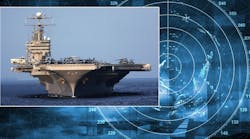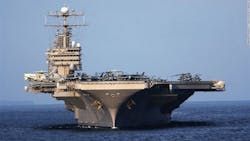Detection and response are key functions in any missile defense system, especially for aircraft carriers at sea. The U.S. Navy did not make the choice of its carrier defensive system lightly, selecting Lockheed Martin for the next Ship Self-Defense System (SSDS) Combat System Engineering Agent (CSEA). The SSDS is a combat detection system that protects against anti-ship missile attacks for aircraft carriers and amphibious large-deck ship classes. As part of the contract, Lockheed Martin will evolve the SSDS combat system, beginning with SSDS Build 12, making new capability upgrades and maintaining SSDS in-service baselines.
Lockheed Martin has been selected by the U.S. Navy to provide anti-missile defensive capabilities to carrier-class ships. (Courtesy of Lockheed Martin)
“The Lockheed Martin CSEA team recognizes the critical role the Aircraft Carrier plays in American power projection and the central role Large Deck Amphibious Ships serve in defense of our nation and our allies,” said Jim Sheridan, vice-president, Naval Combat and Missile Defense Systems, Lockheed Martin. “These missions require the highest standards of systems engineering, performance analysis, software development, integration, and test to deliver an integrated Ship Self-Defense System. We are proud to have been selected by the Navy for this important program.”
Lockheed Martin has considerable experience in providing integrated combat systems for U.S and international navies, serving as the Aegis CSEA. The company developed the Common Source Library (CSL), which enables efficient deployment of common software solutions across the Surface Navy, with variation techniques to customize different configurations. The approach has made it possible to deliver weapons systems focused on the needs of the U.S. Coast Guard and Littoral Combat Ship that were derived from the technology employed in the U.S. Navy’s Aegis systems. “We are excited to extend our Aegis CSEA and Frigate Weapon System experience to become the SSDS CSEA,” added Sheridan.


